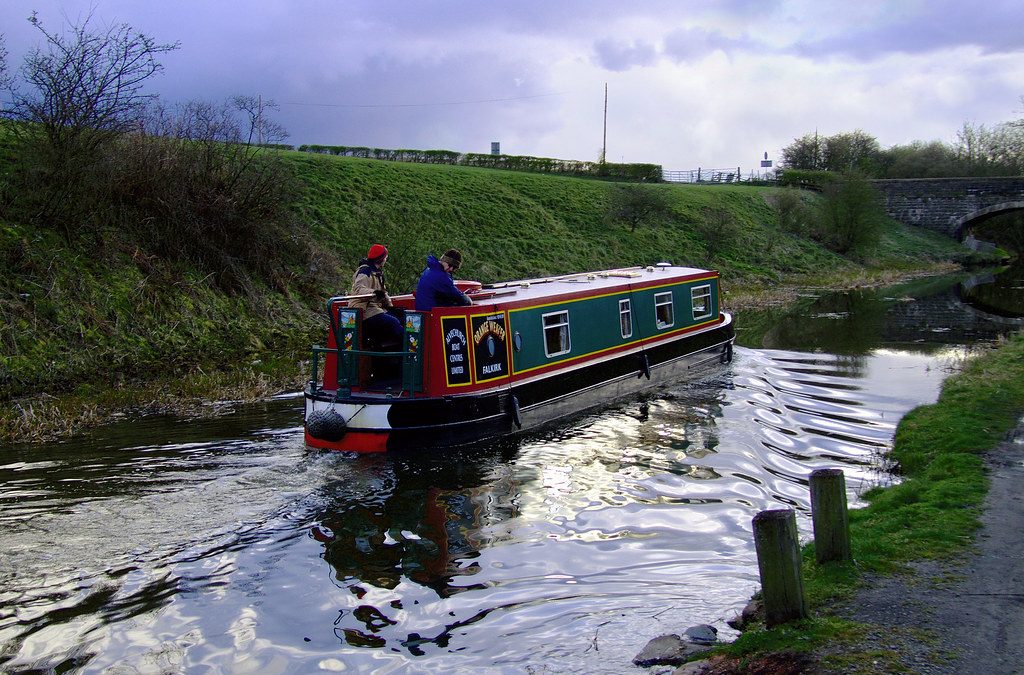Construction of the Union Canal began in 1818 and was completed in 1822. It was designed by the renowned civil engineer Hugh Baird, who also worked on the Forth and Clyde Canal. The canal was built using a series of locks to navigate changes in elevation, and it was originally powered by horses that walked along the towpath. Later, steam engines were introduced to power the boats, making transportation even faster. Today, the Union Canal is still in use, primarily for recreational purposes such as boating and fishing.
Origins and Construction
The Union Canal in Scotland was constructed in the early 19th century to transport goods between Edinburgh and Glasgow. The canal was built under the provisions of the Union Canal Act of Parliament in 1817, which authorized the construction of the canal and provided funding for its construction.
The Union Canal was designed by the famous civil engineer Thomas Telford, who also designed the contour canal system that was used to transport goods across the country. Telford’s design for the Union Canal was innovative, as it used a series of locks to raise and lower boats along the canal’s route.
The Edinburgh and Glasgow Union Canal Company was responsible for the construction and operation of the canal. The company was formed in 1818 and was responsible for raising the necessary funds for the construction of the canal. Once the canal was completed, it was used primarily to transport coal and other goods between Edinburgh and Glasgow.
Engineering Marvels
The Union Canal in West Lothian is home to several engineering marvels that have stood the test of time. These marvels showcase the ingenuity and skill of the engineers who designed and built them.
Aqueducts
The canal features several aqueducts that were built to carry the canal over rivers and valleys. The Avon Aqueduct, for example, is a remarkable feat of engineering that spans the River Avon. It is the longest and tallest aqueduct on the canal, standing at 247 meters long and 26 meters high. Another notable aqueduct is the Slateford Aqueduct, which was the longest and tallest when it was built in 1819. It spans the Water of Leith and is 500 meters long and 18 meters high.
Falkirk Wheel
Leamington Lift Bridge
The Leamington Lift Bridge is a unique structure that was built in 1905. It is a vertical lift bridge that was designed to allow boats to pass through while still allowing trains to cross the canal. The bridge is operated by a hydraulic system that raises and lowers the deck. It is still in use today and is a testament to the skill of the engineers who designed and built it.
Notable Locations
Linlithgow
Edinburgh
Edinburgh is the capital city of Scotland and is located at the eastern end of the Union Canal. The canal passes through the city’s West End, where it is known as the “Lochrin Basin”. The basin was once a bustling hub of activity, with warehouses, wharfs, and a coal depot. Today, it has been transformed into a vibrant residential and commercial area, with a number of bars, restaurants, and shops.
Falkirk
Falkirk is a town in the Central Lowlands of Scotland, located in the Forth Valley. It is home to the Falkirk Wheel, which is a unique rotating boat lift that connects the Union Canal with the Forth and Clyde Canal. The town also has a number of other attractions, including the Antonine Wall, which is a UNESCO World Heritage Site, and the Callendar House, which is a historic mansion that now serves as a museum.
In addition to these notable locations, the Union Canal passes through a number of other towns and villages, including Wester Hailes, Livingston, Bathgate, and Uphall. Each of these locations has its own unique history and attractions, and visitors to the area are sure to find plenty to see and do along the canal.
Commercial Use and Decline
However, the decline of the canal began with the arrival of the Edinburgh and Glasgow Railway in 1842. The railway provided a faster and more efficient means of transporting goods, and as a result, the canal’s commercial traffic declined significantly.
Despite this, the Union Canal continued to be used for commercial purposes, albeit on a smaller scale. The canal was used to transport goods such as timber, grain, and coal to local markets, and it also served as a means of transportation for local businesses.
In the early 20th century, the canal faced further competition from road transport, which had become more efficient and cost-effective. This led to a further decline in the canal’s commercial use.
Today, the Union Canal is primarily used for leisure activities such as boating and fishing. However, there are still some commercial users of the canal, including a few local businesses that use the canal to transport goods.
The Millennium Link Project
The Millennium Link Project was a major regeneration initiative that aimed to restore the historic waterway of Union Canal in West Lothian. The project was completed in 2002 and involved the construction of the Falkirk Wheel, a boat lift that connects the Union Canal with the Forth and Clyde Canal.
The project was designed to provide a new way for boats to travel between the two canals, which had previously been separated by a 115-foot difference in height. The Falkirk Wheel is the world’s only rotating boat lift and is an engineering marvel that has become a popular tourist attraction.
The Millennium Link Project also included the restoration of 11 locks along the Union Canal, which had fallen into disrepair. The locks were rebuilt using traditional techniques and materials to ensure that they were in keeping with the historic character of the canal.
The project was a huge success and has brought significant economic benefits to the area. The regeneration of the canal has created new opportunities for tourism and leisure activities, as well as providing a new transport link for boats.
Present Day Usage
Tourism
The Union Canal in West Lothian is a popular tourist attraction, with thousands of visitors each year. The canal offers a range of activities, including boat trips, cycling, and walking. The visitor centre at the canal provides information about the history and importance of the canal, as well as information about the local area.
The Linlithgow Union Canal Society is a volunteer-run organisation that offers boat trips along the canal. The society also operates a canal museum, which provides visitors with an insight into the history of the canal and its importance to the local area.
Wildlife Conservation
The Union Canal is home to a wide range of wildlife, including otters, kingfishers, and herons. The canal is also an important habitat for a variety of fish species, including pike, roach, and bream.
The canal is managed by Scottish Canals, who work closely with local wildlife conservation groups to ensure that the canal is a safe and welcoming environment for wildlife.
Cyclists and walkers can enjoy the wildlife along the canal on the towpath, which runs alongside the water. The towpath is also a popular route for those looking to explore the local area on foot or by bike.
Impact on West Lothian
The Union Canal has had a significant impact on West Lothian since its opening in 1822. It provided a vital transport link between Edinburgh and Falkirk, connecting the Forth and Clyde Canal and allowing goods to be transported across the country.
The canal also played a role in the development of the oil industry in West Lothian. The area is known for its sedimentary rocks, including sandstone, which were formed millions of years ago when the region was covered by a shallow sea. These rocks contain oil shale, which was mined and processed to produce oil in the 19th and early 20th centuries. The canal was used to transport the oil to markets across Scotland.
In addition to its economic impact, the Union Canal has also had a significant impact on the heritage of West Lothian. The canal passes through several important archaeological sites, including the Antonine Wall, a UNESCO World Heritage Site that marks the northernmost boundary of the Roman Empire. The canal also passes through several historic towns and villages, including Linlithgow, which is home to a 15th-century palace that was once a residence of the Scottish monarchs.
Future Prospects
The Union Canal in West Lothian has a bright future ahead, with several ongoing initiatives and plans for its development.
Scottish Canals
Scottish Canals, the public corporation responsible for managing the canal network in Scotland, has been working to improve the Union Canal’s infrastructure and facilities. In 2022, Scottish Canals invested £3.5 million in the Union Canal to repair and upgrade several locks and bridges. This investment will ensure that the canal remains safe and accessible for boaters and pedestrians.
Scottish Canals also plans to develop the Union Canal as a tourist destination. The organization is working to create new walking and cycling routes along the canal, as well as new facilities for boaters, such as moorings and boat hire services. These developments will attract more visitors to the area and boost the local economy.
British Waterways
British Waterways, the government agency responsible for managing the canal network in England and Wales, has been involved in the regeneration of the Union Canal area. The agency has worked with local councils and community groups to improve the canal’s surroundings, including the creation of new parks and public spaces.
Regeneration
The regeneration of the Union Canal area is a key priority for local councils and community organizations. The area around the canal has seen significant investment in recent years, with new housing developments, shops, and restaurants opening up. The canal’s proximity to Edinburgh and other major cities in Scotland makes it an attractive location for businesses and investors.

